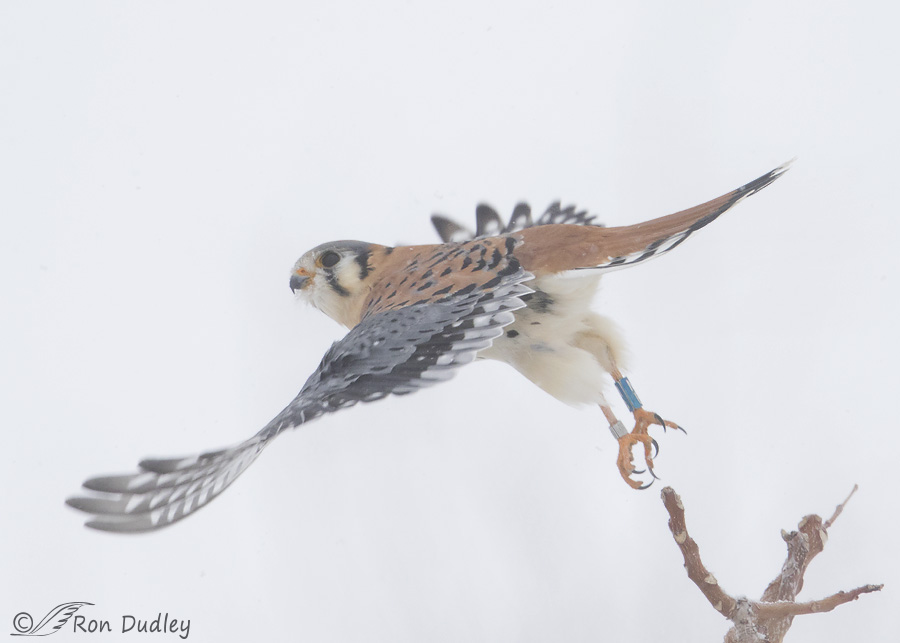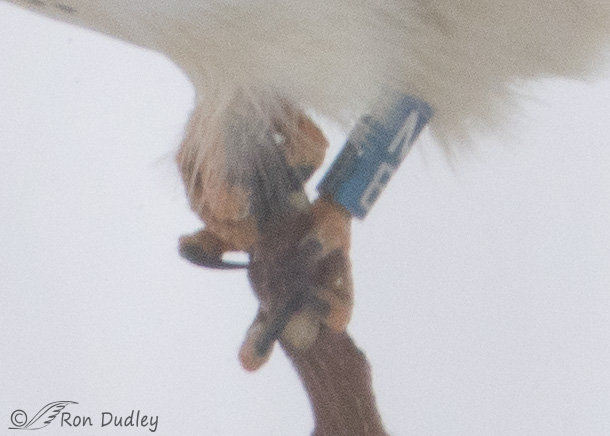You never know what you’ll see when you put a lens on a bird.
It’s my tradition to go shooting on Christmas morning but yesterday I was pushing the envelope because it was foggy and still snowing at Farmington – deplorable conditions for bird photography. It might be slightly hyperbolic to call it a “whiteout” but it was close. It turns out that yesterday was our snowiest Christmas in 100 years but I gritted my teeth and braved the dicey early morning drive to Davis County anyway.

1/2500, f/6.3, ISO 800, Canon EF 500mm f/4L IS II USM + EF 1.4 III Extender, not baited, set up or called in
I almost didn’t even put my lens on this male American Kestrel because of the fog, falling snow, poor light and bright background but I’m glad I did. He was scrunched down on his perch so I couldn’t see his bands until he took off.
I’ve been photographing kestrels at Farmington (and elsewhere) for almost 10 years but this is the first wild kestrel I’ve ever seen that had been banded (although I have photographed at least one escaped falconry kestrel with a band and jesses). And this one is loaded with jewelry – a typical-looking aluminum band on his left leg and a much larger colored band on his right leg.
When I cropped in heavily on this photo I couldn’t read any numbers or letters on the smaller band and the colored band was turned so that the numbers/letters were on the back side so they were unreadable too. However…

In a humongous crop of a previous image, taken just as the kestrel was opening his wings to take off, I could read several letters on the colored band – either an N and a B or an N and an E.
I suspect this bird was banded by my friends at HawkWatch International as part of their ongoing and long-term American Kestrel Study (I believe friend and blog follower Tana Hunter participates in that study). HW uses “unique alpha-numeric color bands because they can be seen from afar with binoculars and spotting scopes, eliminating the need to recapture a bird to know ‘who’ it is”. Their colored bands include only two large digits.
I tried to use HW’s online form to report this bird but it doesn’t allow for attached photos so later today I’ll report this bird to them, including photos, in another way. Banding organizations are pretty ingenious at interpreting even incomplete data in identifying banded birds so I suspect this info and these photos might be useful to them.
If it turns out that this kestrel isn’t one of HW’s birds I’ll report it here to the USGS Bird Banding Laboratory. I encourage everyone to report banded birds if any of the numbers/letters can be read.
These days birds need all the help they can get.
Ron


Ron,
Thanks for braving the storm. I also went out on Christmas but later in the day and found to my delight about 13 (buy my count) Northern Harriers feeding on three different kills. Common for you but extraordinary for me. I had a great time spending some ‘me time’ on Christmas with the birds. Quite a sight. Usually they all flee when I drive up but clearly it was Christmas dinner and they were going to stay around.
Happy Holidays to you all,
Stephen Clayson
Good for you with the harriers, Stephen. I haven’t had as much luck with them so far this year as I’ve had in the past – partly because I’m spending less time at Farmington than I usually do.
Love that you spend Christmas doing what matters to you (and us).
Like Patty I am ambivalent about the banding. I do understand it, and respect the work that so many do. And grieve that it is necessary. And so often necessary because of our interference with their world…
“I do understand it, and respect the work that so many do. And grieve that it is necessary.”
Yup, I heartily agree, EC – especially with your last sentence in my quote above.
I’m glad you made it out and back in one piece yesterday. Great shot of the kestrel take off. It looks like he’s starting to bank left; either that, or he’s looking over his shoulder to say toodleoo.
I also have mixed feelings about seeing banded/tagged/collared wildlife. The scientist in me totally gets it and is very appreciative of those who do fieldwork. The “animal mom” part, not so much. Those bands look pretty frosty.
I concur with your last paragraph, Marty. But I’m resigned to banding being a necessary evil. When it’s done right (and for good reasons which isn’t always the case) birds benefit overall. That’s one of the reasons I’m such a strong supporter of HW – they know what they’re doing and they don’t band unnecessarily.
Thanks, Ron, for the photos and info about the bands. I too, am anxious to hear the “rest of the story!”
There are many saguaros in the wash behind my house in Phoenix and a female Kestrel perches on the tallest one to sun herself and hunt. I am only guessing that it is the same one! In the future I will check carefully for bands.
If I said it was very cold here would you believe me?
Happy New Year!
“If I said it was very cold here would you believe me?”
Like a lot of things, cold is relative, Pat. Temps that I now think are cold here in Utah were absolutely mild compared to the temps I used to endure in northern MT (30 miles from the Alberta border).
Like I frequently say you never know unless you go. Glad you ventured out. I hope to get out Tuesday or Wednesday.
Holidays always come with obligations don’t they. Plus the storm brought me a feathered patient that needs transport today to the center.
Thank you for taking care of the feathered friend. I hope it will be OK.
“you never know unless you go”
Ha, that’s been my mantra for years, April. I say it aloud several times each week. Good luck to your “feathered patient”!
A beautiful shot of a beautiful little bird…never crazy about seeing the “leg irons” even though I understand their value….
I have mixed feelings about bands (and the banding process) too, Patty.
Wonderful picture!
The bands look to me like they say N B.
Thank you, Levi.
By the way, I, like a lot of your readers, have mixed feelings when I see a banded, collared, or tagged wild animal. I understand it from a scientific standpoint, and know how much good it does for wildlife. But from a personal standpoint, I know that while it causes no actual physical harm to the animal, it is still accomplished (in some situations) by driving huge, powerful animals into nets from planes or choppers, tranquilizing them, and them fitting them with collars or tags as if they were pets. Maybe if the animal isn’t threatened, they don’t need to band or collar it. Whatever you do, you don’t mess with wildlife. I still think that they do good for wildlife. It is a complicated topic.
At last that’s how I’ve heard they radio-collar polar bears up North.
“It is a complicated topic”
It sure as the devil is, Levi. Banding (or collaring or tagging) is nearly always traumatic for the recipient, no matter the species. But the info, if it’s a well-designed study, can have definite benefits for the species involved.
What a beauty! Like Arwen, I could contemplate their intricate and stunning gorgeousness for a lifetime without losing interest. It will be interesting to hear if you can get more information on this guy!
It breaks my heart that Kestrels are struggling in a lot of areas. On the plus side, they’re abundant where I’m moving in Kingman, AZ. I would suspect that the slow(er) pace of human development and less use of pesticides/poisons are part of the answer for that. But as always, I could be wrong. That’s always available.
I think I DO have more info now, Laura. I’m hoping to report on it tomorrow.
I’m thinking the band says M B. I’m glad you took this shot for two reasons: 1) it could help banding organizations; 2) I love seeing Kestrel photos. It may not be among your best Kestrel shots, but I love the way the feather patterns of the wings show. I feel like I could spend hours contemplating the markings.
“I’m thinking the band says M B”
You’re absolutely correct about that, Susan! I’ve had some feedback about those numbers and some other things from HW. More tomorrow…
I know We band screech owls around here but never heard of kestrels being banded. So always something to learn. Curious on story of the bird. Also love those little kestrels they seem to be very abundant this year!!! Love pose and position of kestrel.
Thanks, Marina. I’m surprised that I’ve never before seen a banded kestrel.
This one has two bands, a silver one, does this have any meaning?
Yes, it does, Steven. The colors of the band(s), which bands are on which legs and the numbers/letters on the bands all have significance for identifying the bird.
Beautiful shot even if “foggy” and catching the bands, particularly when you may know where the one came from is exciting! A cousin in St. Anthony, ID said they had an “old fashioned Canadian blizzard” yesterday with many vehicles in the ditch. We just got the edges here!
A cousin in St. Anthony, ID said they had an “old fashioned Canadian blizzard” yesterday with many vehicles in the ditch. We just got the edges here!
Roads were a mess around here too, Judy. Reminded me of my Montana days (without the wind…)
The wind start today.
Very interesting. Can’t wait to hear more.
Stay tuned, Arwen…